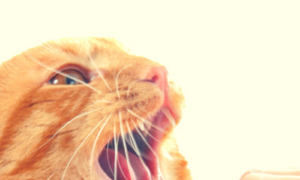Bullying, and how to prevent it, is receiving a lot of attention in the media. Did you know cats can be bullies too? Do you know what cat behavior to look for to determine if your cat is a bully?
Disclosure: This post contains affiliate links. We receive a small commission on goods purchased via these links, at no additional cost to you.
Here are some warning signs:
Common Cat Bullying Behaviors
Blocking entry to the litter box
This is a “power play” designed to intimidate other cats lower in the hierarchy. A good rule of thumb is to provide one more litter box than there are cats in the house. This ensures all cats have access to a litter box when needed. Place the box in a location with easy entry/exit options, rather than a corner.
Limiting Availability To Food And Water Dishes
This is another “power play” to intimidate other cats in the house. If necessary, feed the cats in separate locations. If one cat is not fond of or is not able to jump, feed one cat on a higher surface. I have a friend that feeds one cat on top of the washer and the other on the floor, since one cat is too short to get up on the washer.
The cat exhibiting aggressive behavior may feel as though the hierarchy has been violated. Feeding the leader first shows him respect and can help diffuse the aggression.
Claiming Certain Resting Areas
Cats are very territorial. Certain areas of the house, like the bed where you sleep, are considered “prime real estate” in the cat hierarchy. A cat bully will often physically push another cat out of the way or attack another cat that is moving in on their territory.
Bad cat behavior is often associated with time sharing. Providing the lead feline prime time in the prized resting area shows him his place in the hierarchy is being observed. Other cats in the house can have access to the prized areas at various other times of the day.
Staring
The stare is considered a challenge in the cat world. A cat continually staring down another in the house is looking for a fight.
Conditions That May Lead To Bullying
These bullying behaviors often occur after bringing another feline into the home. Cats need time to adjust to another coming into their area, and to determine where each will fall in the hierarchy.
Occasionally, bullying will occur if the dominant cat passes away. The cat that perceives him/herself as the new leader may begin bullying another resident cat in an attempt to secure his position.
Diffusing Bullying Situations
When you observe one cat bullying another, it is important to diffuse the situation. Ensure the cat being bullied has escape routes to prevent him/her from being trapped by the aggressor.
Redirection
In a recent case of bullying I observed, the aggressor stalked the other resident cat and would often attack her. To redirect this behavior, when you observe the aggressor staring at the other cat, use a toy to distract him.
Wand toys are a good option in this scenario. They give the aggressor an opportunity to use his hunting skills on the toy rather than a cat sibling. These toys also help burn pent up energy to lessen the hunting urge.
Essential Oils/Pheromones
Pheromones can assist in resolving bullying situations. Check out the Feliway MultiCat Calming Diffuser Kit Another option to help with anxiety includes Rescue Remedy.






